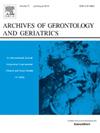Associations of serum uric acid-to-high density lipoprotein cholesterol ratio with age-related diseases and mortality among older population in the United States
IF 3.5
3区 医学
Q2 GERIATRICS & GERONTOLOGY
引用次数: 0
Abstract
Background
Older adults experience numerous physiological and socioeconomic changes that increase the risk of chronic diseases. The uric acid to high-density lipoprotein cholesterol ratio (UHR) has emerged as a potential biomarker for assessing various health conditions. This study aimed to investigate the relationship between UHR and the prevalence of age-related diseases and mortality in a nationally representative sample of older adults in the United States.
Methods
This retrospective cohort study utilized data from the National Health and Nutrition Examination Surveys (NHANES) 2001–2016 including 17,968 participants aged ≥ 50 years. Mortality data were obtained through the National Death Index (NDI) until December 31, 2019. UHR was calculated by dividing serum uric acid (SUA) by high-density lipoprotein cholesterol (HDL-C). Statistical analyses included Kaplan-Meier, logistic regression models, COX regression, restricted cubic spline (RCS), receiver operating characteristic (ROC), net reclassification index (NRI), integrated discrimination improvement (IDI), and mediation analyses.
Results
Significant positive associations were found between UHR levels and the incidence of hypertension, diabetes, chronic kidney disease (CKD), and cardiovascular disease (CVD). Higher UHR levels also correlated with increased cardiovascular and all-cause mortality. Non-linear regressions were observed between UHR and the morbidity of diabetes (p = 0.039), CVD (p = 0.036), all-cause mortality (p = 0.004), with a consistent inflection point at 0.1067478. Subgroup analyses indicated potential effect modifications by gender, BMI, alcohol and drug consumption. UHR outperformed SUA and HDL-C in predicting CVD, as demonstrated by ROC curves and validated by NRI and IDI scores. Mediation analysis indicated that renal impairment partially mediated the link between UHR and all-cause mortality (mediation ratio: 27.39 %).
Conclusion
UHR was significantly associated with the incidence of age-related diseases and mortality in adults aged over 50 years. The study provided evidence that UHR may be a more effective predictor of CVD than SUA or HDL-C alone. Our findings highlighted the potential clinical utility of UHR as a diagnostic and prognostic tool in the older population. Further research is required to generalize conclusions and understand underlying mechanisms.
求助全文
约1分钟内获得全文
求助全文
来源期刊
CiteScore
7.30
自引率
5.00%
发文量
198
审稿时长
16 days
期刊介绍:
Archives of Gerontology and Geriatrics provides a medium for the publication of papers from the fields of experimental gerontology and clinical and social geriatrics. The principal aim of the journal is to facilitate the exchange of information between specialists in these three fields of gerontological research. Experimental papers dealing with the basic mechanisms of aging at molecular, cellular, tissue or organ levels will be published.
Clinical papers will be accepted if they provide sufficiently new information or are of fundamental importance for the knowledge of human aging. Purely descriptive clinical papers will be accepted only if the results permit further interpretation. Papers dealing with anti-aging pharmacological preparations in humans are welcome. Papers on the social aspects of geriatrics will be accepted if they are of general interest regarding the epidemiology of aging and the efficiency and working methods of the social organizations for the health care of the elderly.

 求助内容:
求助内容: 应助结果提醒方式:
应助结果提醒方式:


